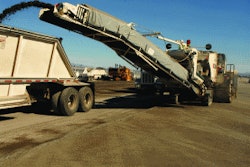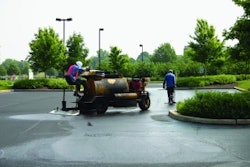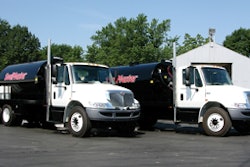
As the work of milling runway 18L 36R at the Huntsville International Airport droned on, various workers offered various interpretations of the spec they had to meet.
"One-eighth of an inch." That's the correct number.
"The thickness of a nickel." Grab your vernier calipers and your pocket change and you'll see that an eighth-inch is very close to the thickness of two nickels.
"Two-hundredths of an inch." No, an eighth of an inch is 6.25 times bigger than that.
"Two-hundredths of a foot." That would be 0.24 inches, not quite twice the actual spec of one-eighth (0.125) inch.
One thing on which everyone agreed: the spec was tight. Brian Self, the take-off coordinator for Wiregrass Construction Company, the firm doing the milling and repaving, made the number even more daunting.
"It's not plus-or-minus an eighth," he explains. "The way we have it configured is we're milling to a depth of three inches, plus an eighth, minus zero."
Garrett Pass, area manager for Wiregrass, says even that description doesn't fully explain the complexity of the spec.
"We are milling to a profile grade and slope," Pass says. "So some of the depth may be 3 inches, some may be 2.25 inches. This varies during the length of the runway because the engineering firm gave us a new centerline profile and slope. We are milling to 3 inches under this new finish grade elevation that the owner/engineer wants.
"It's more difficult to stay within the eighth-inch due to varying depths," he continues. "This is where the millimeter GPS machine control is really paying off. Essentially this is the first leveling pass done on the runway. Then we will have two layers of asphalt to place with the GPS machine control to get within the correct elevation spec."
Actually there were two things on which everyone in the field agreed. The second was that an eighth of an inch seemed excessively tight. Arbitrary. Fussy even. Why would the airport authority require such tight tolerances?
It's the cost, of course
Stan Hogan is happy to explain. Hogan is the director of capital improvement for the Huntsville International Airport (or HSV, the International Air Transport Association's three-letter code for the facility).
"In the past there have been instances of a contractor milling too deeply," he says. "To bring the repaved surface back up to grade, more asphalt is brought in than would be required had the milling been done to specification. To control for that we set the eighth-inch spec. Since we pay for asphalt by the ton, bringing in more than is required would drive up our cost."
Milling even a little deeper than required could quickly drive up cost on this project. The runway is 10,000 feet long and 150 feet wide.
There are also taxiways, or "connectors" and "fillets" in airport parlance.
The connectors do what their name suggests; they connect runways and terminals to each other. The fillets (FILL-its) are the radiused intersections. Seen from the air, they look like their namesake counterparts from the machining and brazing trades — smooth, sweeping junctions between two linear components.
The runway alone will require about 38,000 tons of asphalt for resurfacing. Add another 2,000 tons for the connectors and fillets. Add nothing for overmilling because overmilling isn't an option.
Another cost consideration is the amount of time the runway will be closed for resurfacing.
"Time is part of our liquidated damages formula," says Hogan.
Time equals money for the air cargo lines that use runway 18L 36R. When their main runway is closed, these carriers have to use other runways and taxi farther to their terminals. Doing so increases both time and fuel consumption.
Because time is so critical, the time to completion is used in determining the true cost of a contractor's proposal. Wiregrass's dollar figures were competitive, but they also got a big advantage with the number of days they quoted.
"Wiregrass says they'd have the entire resurfacing job done in 170 days," says Hogan. "The next nearest bidder quoted 265 days."
Work began on October 1, 2008.
A technological leg up
The runway alone is 1.5 million square feet. Connectors and fillets add about 78,000 square feet. Every inch gets milled. In seven-foot passes. Then it gets repaved. All in 170 days.
How was Wiregrass able to bid to complete the job in one-third fewer days than their next nearest competitor? In a word: technology.
"We use Topcon products on all of the 20 or so pavers we have working in Florida and Alabama," Pass says. "We're using millimeter GPS machine control here for milling. When we're done milling we'll move that system to our paver. Performance of the system has been even better than we expected. We milled 400 feet our first day on site and hit perfect grade and slope."
The performance didn't diminish with time. On the day these interviews were conducted, about three weeks after work began, the fillet being milled was checked and found to be within 0.008 inches of spec.
That accuracy is more than 15 times greater than required. It's interesting to note that the normal pointed foot of the rover used to check the milling is replaced with a round cup about the diameter of a half-dollar.
This spreads out the footprint and normalizes the reading over a larger area; a pointed tip could nestle in between some aggregate or drop into a milled groove and give a false reading.
Initial setup is the key to obtaining and maintaining accuracy, says Mike Dulion, Topcon machine control specialist with Earl Dudley Associates Inc. of Birmingham, AL. Earl Dudley is the Topcon dealer that services Wiregrass.
Each machine has idiosyncrasies that need to be addressed during setup. Many of those quirks relate to the hydraulic system and how quickly the valves respond to input.
Little things affect that response rate, things such as wear on the valve bodies and the condition of seals in the hydraulic system.
If the valves over-react, the result is a washboard surface. Using a Topcon 9168 control box, Dulion selects options from a menu until the mmGPS system is perfectly matched to this particular Wirtgen W2000 planer. That process takes about 45 minutes.
A shorter setup process is required when the W2000 is moved to a new location on site. On this particular day the setup took about 20 minutes, which was the time it took for service technicians to replace some teeth on the machine.
Not all the tools on site are as sophisticated as the mmGPS system. Simple builder's levels are used to check the outslope. Specs call for a 1% slope to 25 feet either side of the centerline and then a 1.5% slope to the edges.
Total agreement
The nature of the eighth-inch spec was a matter of debate. To the workers it seemed unnecessarily tight, a requirement that would be nearly impossible to maintain with stakes and stringlines or even sonic systems.
To Hogan, as director of capital improvements, it seemed like a reasonable way to guard against cost overruns. One point on which there was absolute agreement: mmGPS machine control is wonderful stuff.
"I've been here 23 1/2 years," says Hogan. "This is the best mill job we've ever had. The accuracy on milling is outstanding and I expect the same will be true when we get to paving."
The spec on paving is 2.5 inches, plus 0.5 inches, minus zero. "This is also the first millimeter GPS milling job we've had," he says.
Asked if mmGPS would be a requirement in future RFPs, Hogan says, "Oh, yes. I think that's safe to say."
Those associated with Wiregrass were uniform in their praise. "Holding an eighth inch would have scared everybody," says Garrett Pass, "If millimeter GPS had not been available. Based on our experience here, we'll start our next job with similar specs from a position of confidence."
Brian Self, the take-off coordinator, says that mmGPS is so precise that it puts an extra layer of responsibility on whoever's doing the plan; the operator won't be making adjustment on the fly.
"You have to make sure that what goes into the machine is what you want the ground to look like," he says.
This was Self's first project with this bundle of technology, including Topcon's Pocket 3D and supporting software. Access to such tools was one of the reasons Self came to Wiregrass. "I was excited that they were willing to invest in the technology and equipment."
Enhancing their technological edge is just one way Wiregrass stays competitive. They have seven asphalt plants in Alabama. Although the $6 million HSV job was a big one, Wiregrass does a lot of work in the region, including curb and gutter, highway, and subdivision jobs.
They were still sorting out their acquisition of Shelby Contracting when this job came along; several interviewees referred to the firm as "Wiregrass-Shelby." And the influx of employees from other firms, such as APAC and Saiia, spread the roots of the company's family tree across the Southeast.
Tommy Pigg, who like Garrett Pass, is an area manager with Wiregrass, says the potential of mmGPS is great.
"I'm not sure what the total impact of the technology will be on our business, but I know Wiregrass won't do another job like this without it."




















